Report on Bitcoin and Ethereum Blockchain Applications Analysis
VerifiedAdded on 2023/06/14
|15
|1483
|82
Report
AI Summary
This report provides a detailed analysis of blockchain applications, focusing on Bitcoin and Ethereum. It begins by explaining the purpose and working model of each cryptocurrency, highlighting the decentralized nature of Bitcoin as a peer-to-peer payment network and Ethereum as a platform for building decentralized applications. The report then addresses the scalability issues faced by both Bitcoin and Ethereum, comparing their transaction processing capacities to mainstream payment systems like Visa and PayPal. Furthermore, it discusses the features and weaknesses of each application, including security vulnerabilities and the lack of central authority. The report concludes by emphasizing that despite the innovative technologies employed, cryptocurrencies are not immune to fraud and other issues. Desklib provides access to this and many other solved assignments for students.
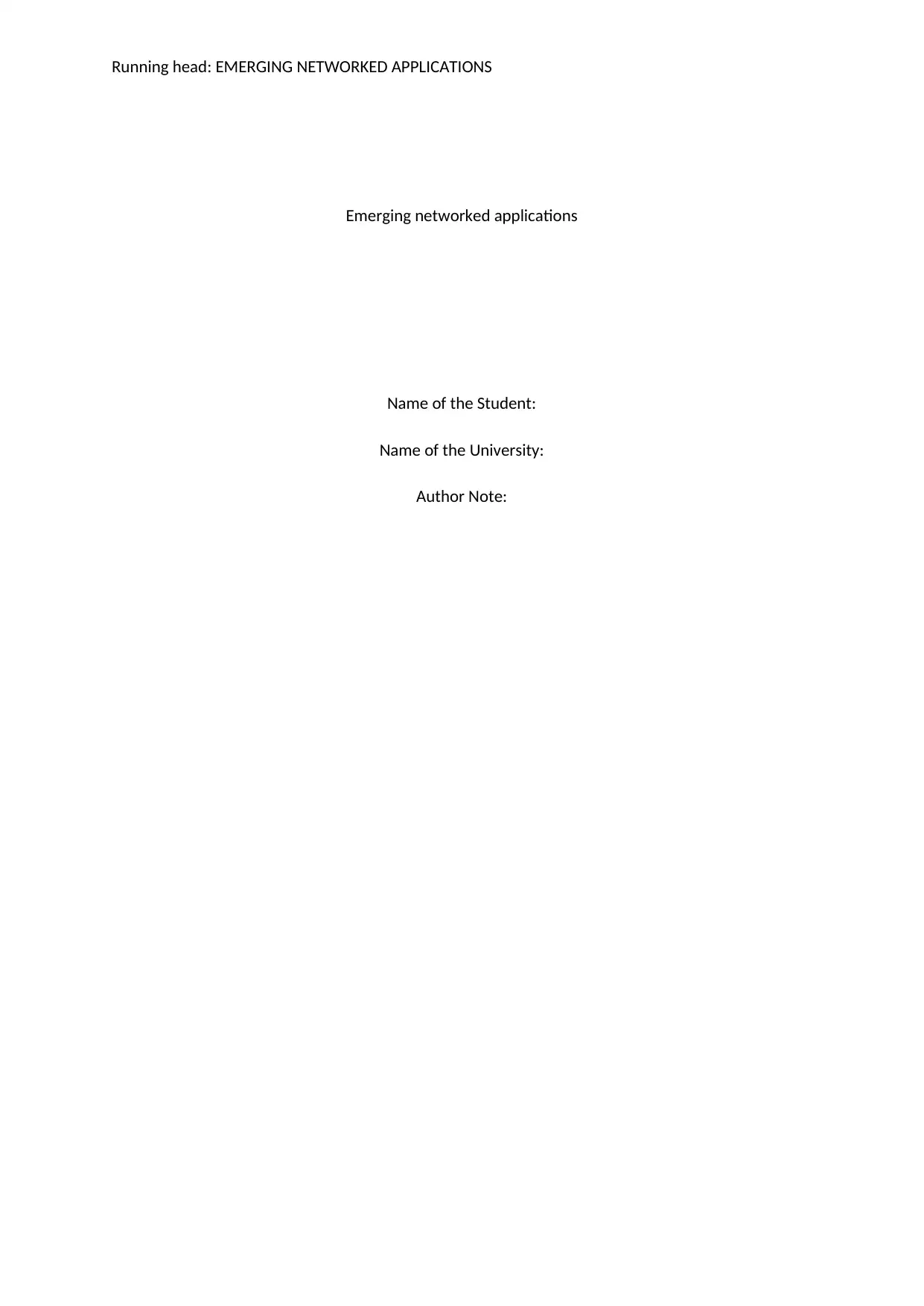
Running head: EMERGING NETWORKED APPLICATIONS
Emerging networked applications
Name of the Student:
Name of the University:
Author Note:
Emerging networked applications
Name of the Student:
Name of the University:
Author Note:
Paraphrase This Document
Need a fresh take? Get an instant paraphrase of this document with our AI Paraphraser
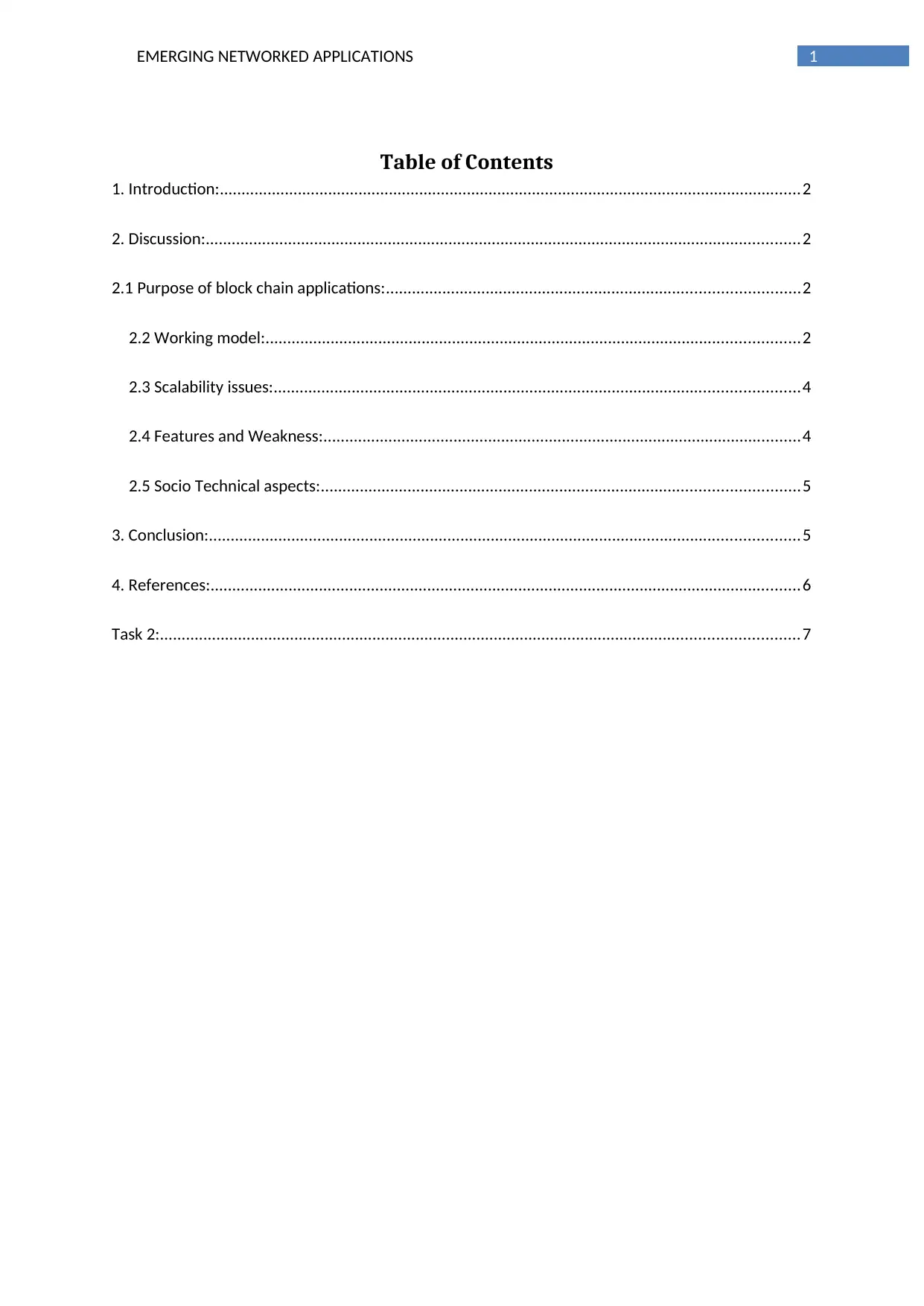
1EMERGING NETWORKED APPLICATIONS
Table of Contents
1. Introduction:......................................................................................................................................2
2. Discussion:.........................................................................................................................................2
2.1 Purpose of block chain applications:...............................................................................................2
2.2 Working model:...........................................................................................................................2
2.3 Scalability issues:.........................................................................................................................4
2.4 Features and Weakness:..............................................................................................................4
2.5 Socio Technical aspects:..............................................................................................................5
3. Conclusion:........................................................................................................................................5
4. References:........................................................................................................................................6
Task 2:...................................................................................................................................................7
Table of Contents
1. Introduction:......................................................................................................................................2
2. Discussion:.........................................................................................................................................2
2.1 Purpose of block chain applications:...............................................................................................2
2.2 Working model:...........................................................................................................................2
2.3 Scalability issues:.........................................................................................................................4
2.4 Features and Weakness:..............................................................................................................4
2.5 Socio Technical aspects:..............................................................................................................5
3. Conclusion:........................................................................................................................................5
4. References:........................................................................................................................................6
Task 2:...................................................................................................................................................7
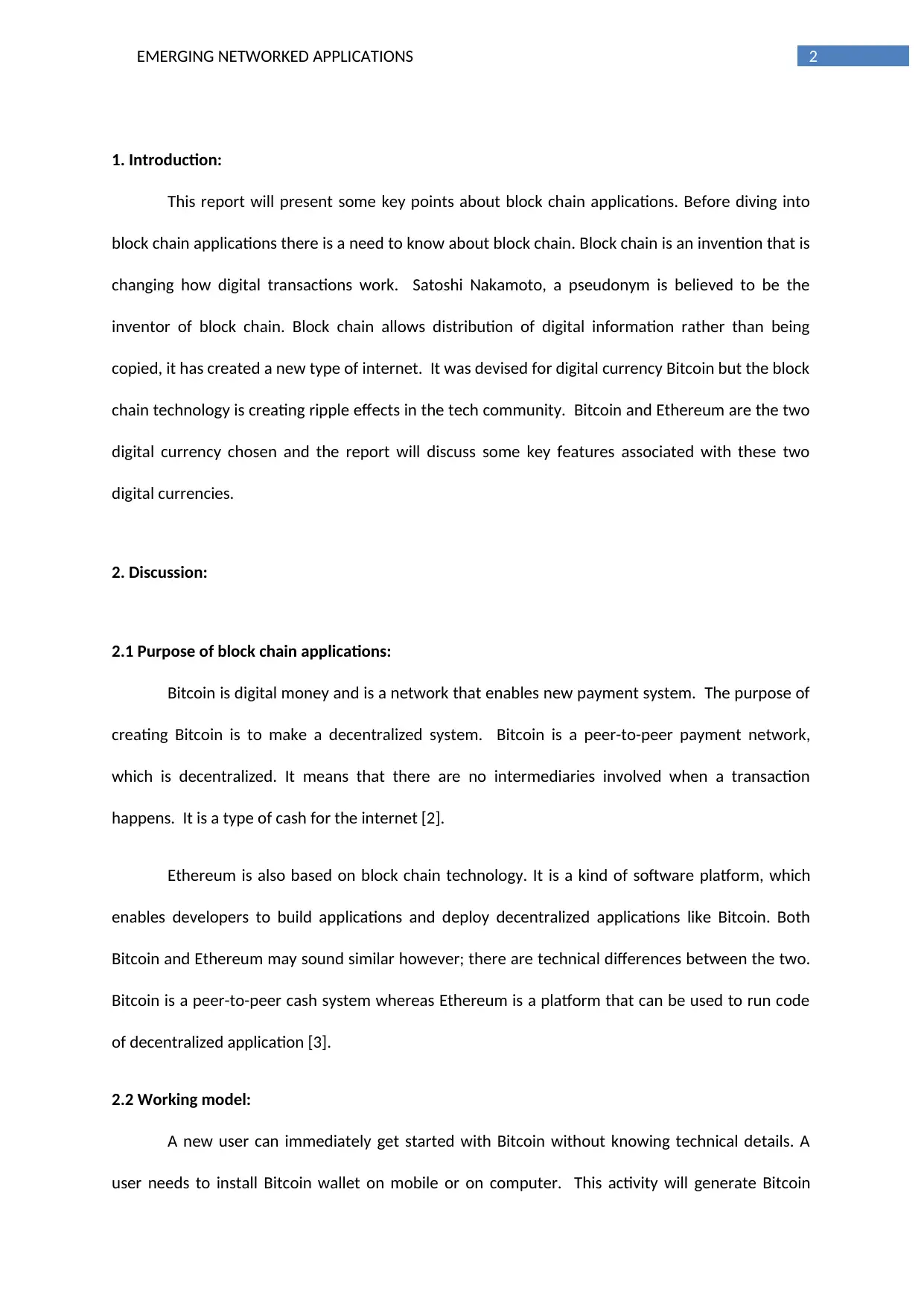
2EMERGING NETWORKED APPLICATIONS
1. Introduction:
This report will present some key points about block chain applications. Before diving into
block chain applications there is a need to know about block chain. Block chain is an invention that is
changing how digital transactions work. Satoshi Nakamoto, a pseudonym is believed to be the
inventor of block chain. Block chain allows distribution of digital information rather than being
copied, it has created a new type of internet. It was devised for digital currency Bitcoin but the block
chain technology is creating ripple effects in the tech community. Bitcoin and Ethereum are the two
digital currency chosen and the report will discuss some key features associated with these two
digital currencies.
2. Discussion:
2.1 Purpose of block chain applications:
Bitcoin is digital money and is a network that enables new payment system. The purpose of
creating Bitcoin is to make a decentralized system. Bitcoin is a peer-to-peer payment network,
which is decentralized. It means that there are no intermediaries involved when a transaction
happens. It is a type of cash for the internet [2].
Ethereum is also based on block chain technology. It is a kind of software platform, which
enables developers to build applications and deploy decentralized applications like Bitcoin. Both
Bitcoin and Ethereum may sound similar however; there are technical differences between the two.
Bitcoin is a peer-to-peer cash system whereas Ethereum is a platform that can be used to run code
of decentralized application [3].
2.2 Working model:
A new user can immediately get started with Bitcoin without knowing technical details. A
user needs to install Bitcoin wallet on mobile or on computer. This activity will generate Bitcoin
1. Introduction:
This report will present some key points about block chain applications. Before diving into
block chain applications there is a need to know about block chain. Block chain is an invention that is
changing how digital transactions work. Satoshi Nakamoto, a pseudonym is believed to be the
inventor of block chain. Block chain allows distribution of digital information rather than being
copied, it has created a new type of internet. It was devised for digital currency Bitcoin but the block
chain technology is creating ripple effects in the tech community. Bitcoin and Ethereum are the two
digital currency chosen and the report will discuss some key features associated with these two
digital currencies.
2. Discussion:
2.1 Purpose of block chain applications:
Bitcoin is digital money and is a network that enables new payment system. The purpose of
creating Bitcoin is to make a decentralized system. Bitcoin is a peer-to-peer payment network,
which is decentralized. It means that there are no intermediaries involved when a transaction
happens. It is a type of cash for the internet [2].
Ethereum is also based on block chain technology. It is a kind of software platform, which
enables developers to build applications and deploy decentralized applications like Bitcoin. Both
Bitcoin and Ethereum may sound similar however; there are technical differences between the two.
Bitcoin is a peer-to-peer cash system whereas Ethereum is a platform that can be used to run code
of decentralized application [3].
2.2 Working model:
A new user can immediately get started with Bitcoin without knowing technical details. A
user needs to install Bitcoin wallet on mobile or on computer. This activity will generate Bitcoin
⊘ This is a preview!⊘
Do you want full access?
Subscribe today to unlock all pages.

Trusted by 1+ million students worldwide
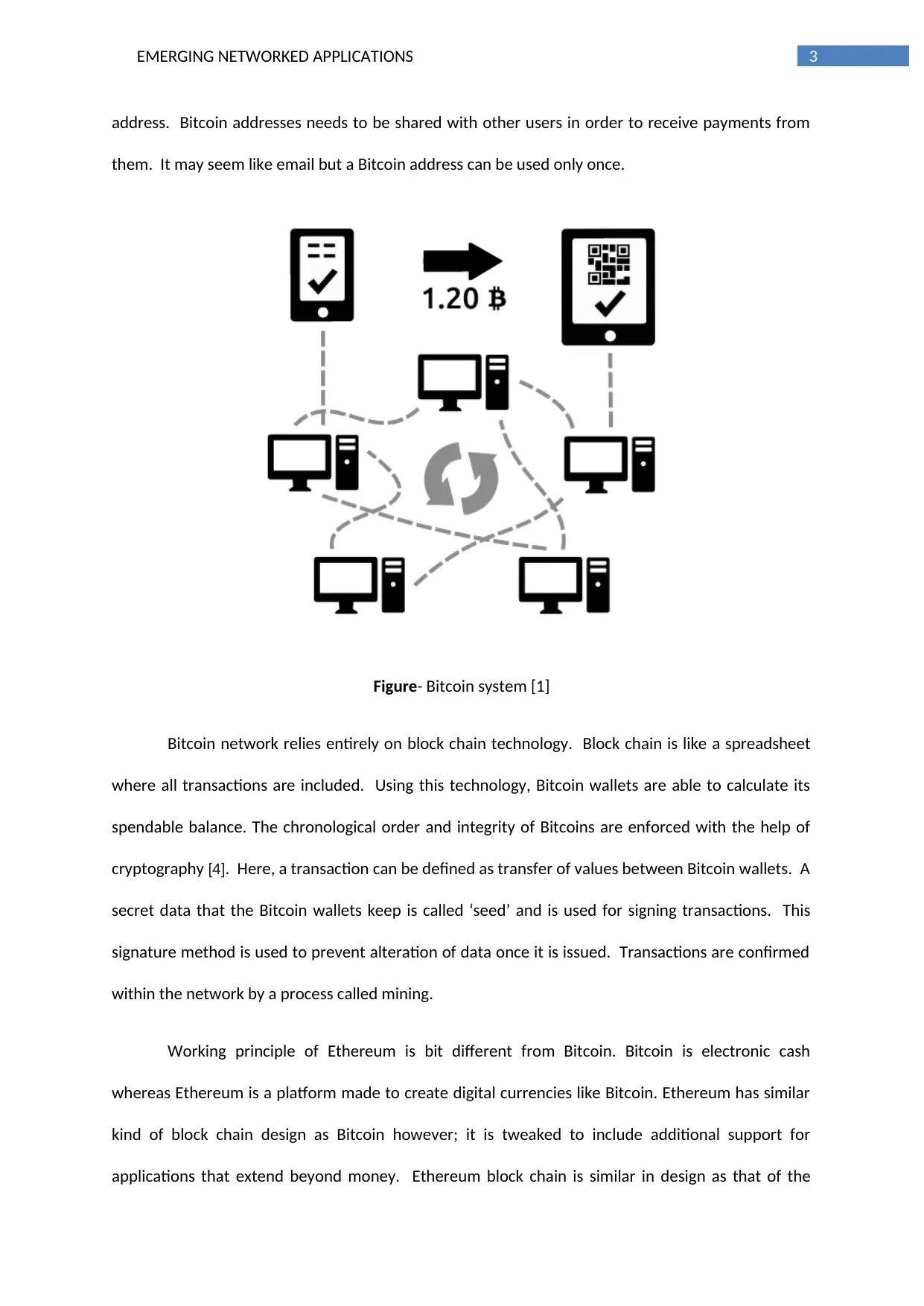
3EMERGING NETWORKED APPLICATIONS
address. Bitcoin addresses needs to be shared with other users in order to receive payments from
them. It may seem like email but a Bitcoin address can be used only once.
Figure- Bitcoin system [1]
Bitcoin network relies entirely on block chain technology. Block chain is like a spreadsheet
where all transactions are included. Using this technology, Bitcoin wallets are able to calculate its
spendable balance. The chronological order and integrity of Bitcoins are enforced with the help of
cryptography [4]. Here, a transaction can be defined as transfer of values between Bitcoin wallets. A
secret data that the Bitcoin wallets keep is called ‘seed’ and is used for signing transactions. This
signature method is used to prevent alteration of data once it is issued. Transactions are confirmed
within the network by a process called mining.
Working principle of Ethereum is bit different from Bitcoin. Bitcoin is electronic cash
whereas Ethereum is a platform made to create digital currencies like Bitcoin. Ethereum has similar
kind of block chain design as Bitcoin however; it is tweaked to include additional support for
applications that extend beyond money. Ethereum block chain is similar in design as that of the
address. Bitcoin addresses needs to be shared with other users in order to receive payments from
them. It may seem like email but a Bitcoin address can be used only once.
Figure- Bitcoin system [1]
Bitcoin network relies entirely on block chain technology. Block chain is like a spreadsheet
where all transactions are included. Using this technology, Bitcoin wallets are able to calculate its
spendable balance. The chronological order and integrity of Bitcoins are enforced with the help of
cryptography [4]. Here, a transaction can be defined as transfer of values between Bitcoin wallets. A
secret data that the Bitcoin wallets keep is called ‘seed’ and is used for signing transactions. This
signature method is used to prevent alteration of data once it is issued. Transactions are confirmed
within the network by a process called mining.
Working principle of Ethereum is bit different from Bitcoin. Bitcoin is electronic cash
whereas Ethereum is a platform made to create digital currencies like Bitcoin. Ethereum has similar
kind of block chain design as Bitcoin however; it is tweaked to include additional support for
applications that extend beyond money. Ethereum block chain is similar in design as that of the
Paraphrase This Document
Need a fresh take? Get an instant paraphrase of this document with our AI Paraphraser
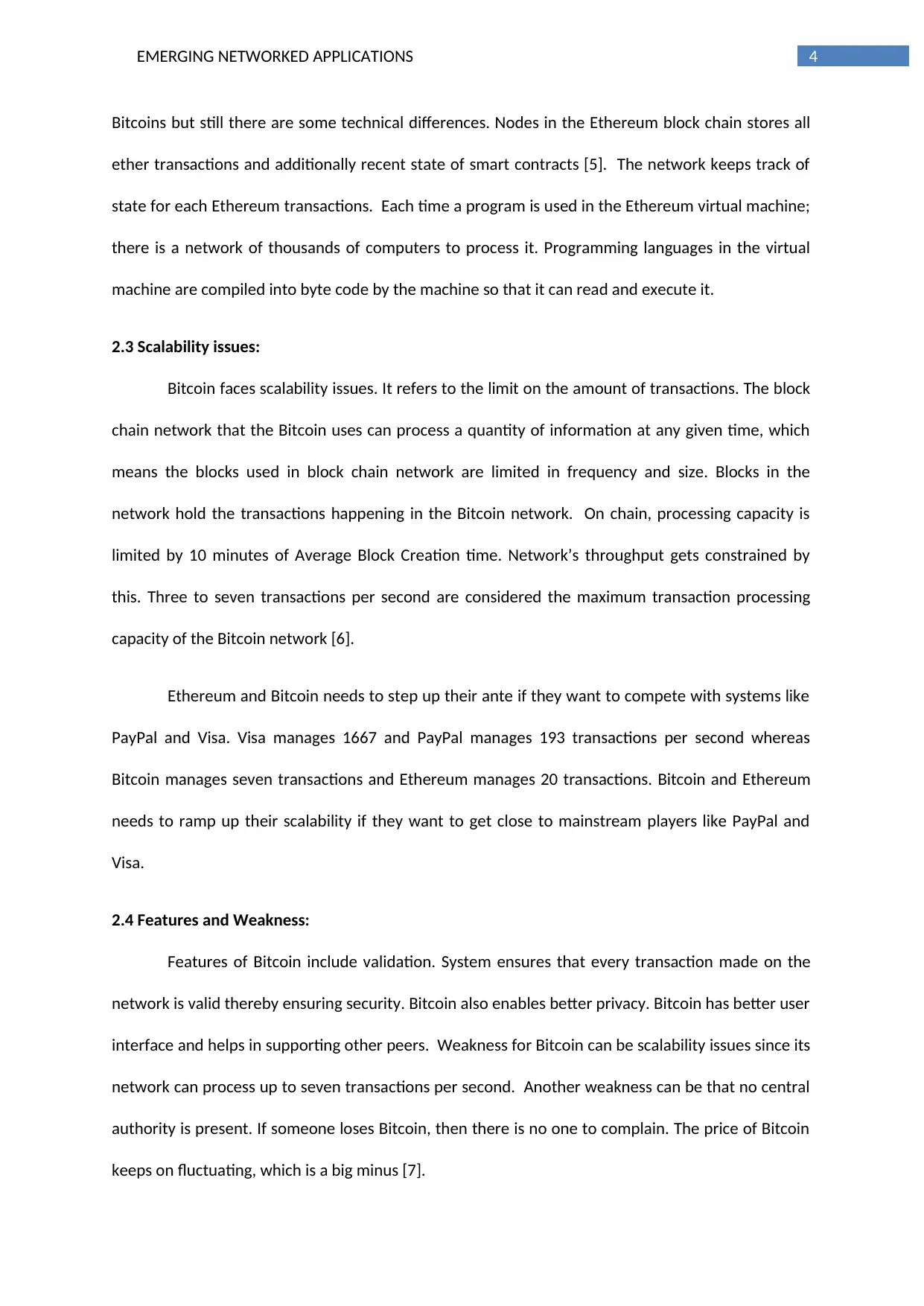
4EMERGING NETWORKED APPLICATIONS
Bitcoins but still there are some technical differences. Nodes in the Ethereum block chain stores all
ether transactions and additionally recent state of smart contracts [5]. The network keeps track of
state for each Ethereum transactions. Each time a program is used in the Ethereum virtual machine;
there is a network of thousands of computers to process it. Programming languages in the virtual
machine are compiled into byte code by the machine so that it can read and execute it.
2.3 Scalability issues:
Bitcoin faces scalability issues. It refers to the limit on the amount of transactions. The block
chain network that the Bitcoin uses can process a quantity of information at any given time, which
means the blocks used in block chain network are limited in frequency and size. Blocks in the
network hold the transactions happening in the Bitcoin network. On chain, processing capacity is
limited by 10 minutes of Average Block Creation time. Network’s throughput gets constrained by
this. Three to seven transactions per second are considered the maximum transaction processing
capacity of the Bitcoin network [6].
Ethereum and Bitcoin needs to step up their ante if they want to compete with systems like
PayPal and Visa. Visa manages 1667 and PayPal manages 193 transactions per second whereas
Bitcoin manages seven transactions and Ethereum manages 20 transactions. Bitcoin and Ethereum
needs to ramp up their scalability if they want to get close to mainstream players like PayPal and
Visa.
2.4 Features and Weakness:
Features of Bitcoin include validation. System ensures that every transaction made on the
network is valid thereby ensuring security. Bitcoin also enables better privacy. Bitcoin has better user
interface and helps in supporting other peers. Weakness for Bitcoin can be scalability issues since its
network can process up to seven transactions per second. Another weakness can be that no central
authority is present. If someone loses Bitcoin, then there is no one to complain. The price of Bitcoin
keeps on fluctuating, which is a big minus [7].
Bitcoins but still there are some technical differences. Nodes in the Ethereum block chain stores all
ether transactions and additionally recent state of smart contracts [5]. The network keeps track of
state for each Ethereum transactions. Each time a program is used in the Ethereum virtual machine;
there is a network of thousands of computers to process it. Programming languages in the virtual
machine are compiled into byte code by the machine so that it can read and execute it.
2.3 Scalability issues:
Bitcoin faces scalability issues. It refers to the limit on the amount of transactions. The block
chain network that the Bitcoin uses can process a quantity of information at any given time, which
means the blocks used in block chain network are limited in frequency and size. Blocks in the
network hold the transactions happening in the Bitcoin network. On chain, processing capacity is
limited by 10 minutes of Average Block Creation time. Network’s throughput gets constrained by
this. Three to seven transactions per second are considered the maximum transaction processing
capacity of the Bitcoin network [6].
Ethereum and Bitcoin needs to step up their ante if they want to compete with systems like
PayPal and Visa. Visa manages 1667 and PayPal manages 193 transactions per second whereas
Bitcoin manages seven transactions and Ethereum manages 20 transactions. Bitcoin and Ethereum
needs to ramp up their scalability if they want to get close to mainstream players like PayPal and
Visa.
2.4 Features and Weakness:
Features of Bitcoin include validation. System ensures that every transaction made on the
network is valid thereby ensuring security. Bitcoin also enables better privacy. Bitcoin has better user
interface and helps in supporting other peers. Weakness for Bitcoin can be scalability issues since its
network can process up to seven transactions per second. Another weakness can be that no central
authority is present. If someone loses Bitcoin, then there is no one to complain. The price of Bitcoin
keeps on fluctuating, which is a big minus [7].

5EMERGING NETWORKED APPLICATIONS
A feature of Ethereum includes the creation of new digital currency via its platform.
Scalability issues are there in Ethereum too. There is lack of documentation for people who wants to
become Ethereum developers.
2.5 Socio Technical aspects:
This includes security issues that crypto currency faces. Bitcoin uses a decentralized model
with an environment that is uncontrollable. This makes the system vulnerable to threats.
Vulnerability in the system is used by hackers to fraud the transactions. This is also true for
Ethereum. Attack may include wallet attacks, mining attacks and network attacks. There is also
double spending in Bitcoin where a user is able to fraud the system by spending same set of Bitcoins
in two different transactions [8].
3. Conclusion:
Therefore, from the report it can be concluded that although crypto currencies uses
innovative technologies they are not immune to fraud and issues. Bitcoin is electronic cash available
on the internet that uses block chain technology to perform peer-to-peer transactions whereas
Etherium provides a platform to develop crypto currencies. There is a difference between the two
block chain applications.
A feature of Ethereum includes the creation of new digital currency via its platform.
Scalability issues are there in Ethereum too. There is lack of documentation for people who wants to
become Ethereum developers.
2.5 Socio Technical aspects:
This includes security issues that crypto currency faces. Bitcoin uses a decentralized model
with an environment that is uncontrollable. This makes the system vulnerable to threats.
Vulnerability in the system is used by hackers to fraud the transactions. This is also true for
Ethereum. Attack may include wallet attacks, mining attacks and network attacks. There is also
double spending in Bitcoin where a user is able to fraud the system by spending same set of Bitcoins
in two different transactions [8].
3. Conclusion:
Therefore, from the report it can be concluded that although crypto currencies uses
innovative technologies they are not immune to fraud and issues. Bitcoin is electronic cash available
on the internet that uses block chain technology to perform peer-to-peer transactions whereas
Etherium provides a platform to develop crypto currencies. There is a difference between the two
block chain applications.
⊘ This is a preview!⊘
Do you want full access?
Subscribe today to unlock all pages.

Trusted by 1+ million students worldwide

6EMERGING NETWORKED APPLICATIONS
4. References:
[1]"How does Bitcoin work? - Bitcoin", Bitcoin.org, 2018. [Online]. Available:
https://bitcoin.org/en/how-it-works. [Accessed: 10- Apr- 2018].
[2]Segendorf, B., ‘What is bitcoin’, Sveriges Riksbank Economic Review, 2014, pp.71-87.
[3]Buterin, V., ‘A next-generation smart contract and decentralized application platform’, white
paper, 2014.
[4]Iavorschi, M.,’The bitcoin project and the free market.’, CES Working Papers, 2013, pp.529-534.
[5]Nair, G.R. and Sebastian, S., BlockChain Technology Centralised Ledger to Distributed
Ledger,2017.
[6]Blundell-Wignall, A., ‘The Bitcoin question: Currency versus trust-less transfer technology.’, OECD
Working Papers on Finance, Insurance and Private Pensions, (37), 2014, p.1.
[7]ShenTu, Q. and Yu, J., ‘Research on Anonymization and De-anonymization in the Bitcoin
System.’, arXiv preprint arXiv:1510.07782, 2015.
[8]Conti, M., Lal, C. and Ruj, S., ‘A survey on security and privacy issues of bitcoin.’, arXiv preprint
arXiv:1706.00916, 2017.
4. References:
[1]"How does Bitcoin work? - Bitcoin", Bitcoin.org, 2018. [Online]. Available:
https://bitcoin.org/en/how-it-works. [Accessed: 10- Apr- 2018].
[2]Segendorf, B., ‘What is bitcoin’, Sveriges Riksbank Economic Review, 2014, pp.71-87.
[3]Buterin, V., ‘A next-generation smart contract and decentralized application platform’, white
paper, 2014.
[4]Iavorschi, M.,’The bitcoin project and the free market.’, CES Working Papers, 2013, pp.529-534.
[5]Nair, G.R. and Sebastian, S., BlockChain Technology Centralised Ledger to Distributed
Ledger,2017.
[6]Blundell-Wignall, A., ‘The Bitcoin question: Currency versus trust-less transfer technology.’, OECD
Working Papers on Finance, Insurance and Private Pensions, (37), 2014, p.1.
[7]ShenTu, Q. and Yu, J., ‘Research on Anonymization and De-anonymization in the Bitcoin
System.’, arXiv preprint arXiv:1510.07782, 2015.
[8]Conti, M., Lal, C. and Ruj, S., ‘A survey on security and privacy issues of bitcoin.’, arXiv preprint
arXiv:1706.00916, 2017.
Paraphrase This Document
Need a fresh take? Get an instant paraphrase of this document with our AI Paraphraser

7EMERGING NETWORKED APPLICATIONS
Task 2:
Following pages will provide the PowerPoint slides.
Task 2:
Following pages will provide the PowerPoint slides.
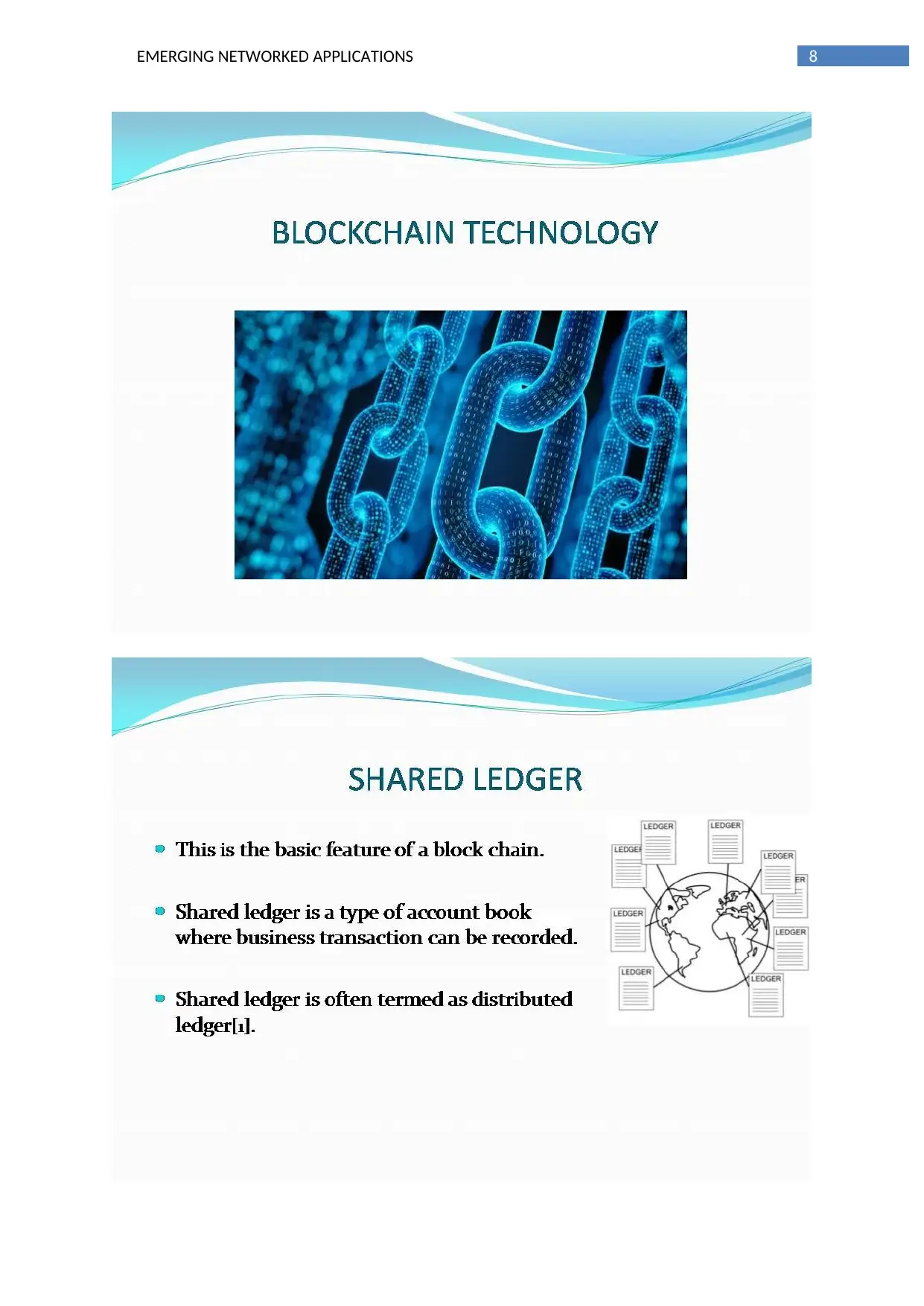
8EMERGING NETWORKED APPLICATIONS
⊘ This is a preview!⊘
Do you want full access?
Subscribe today to unlock all pages.

Trusted by 1+ million students worldwide
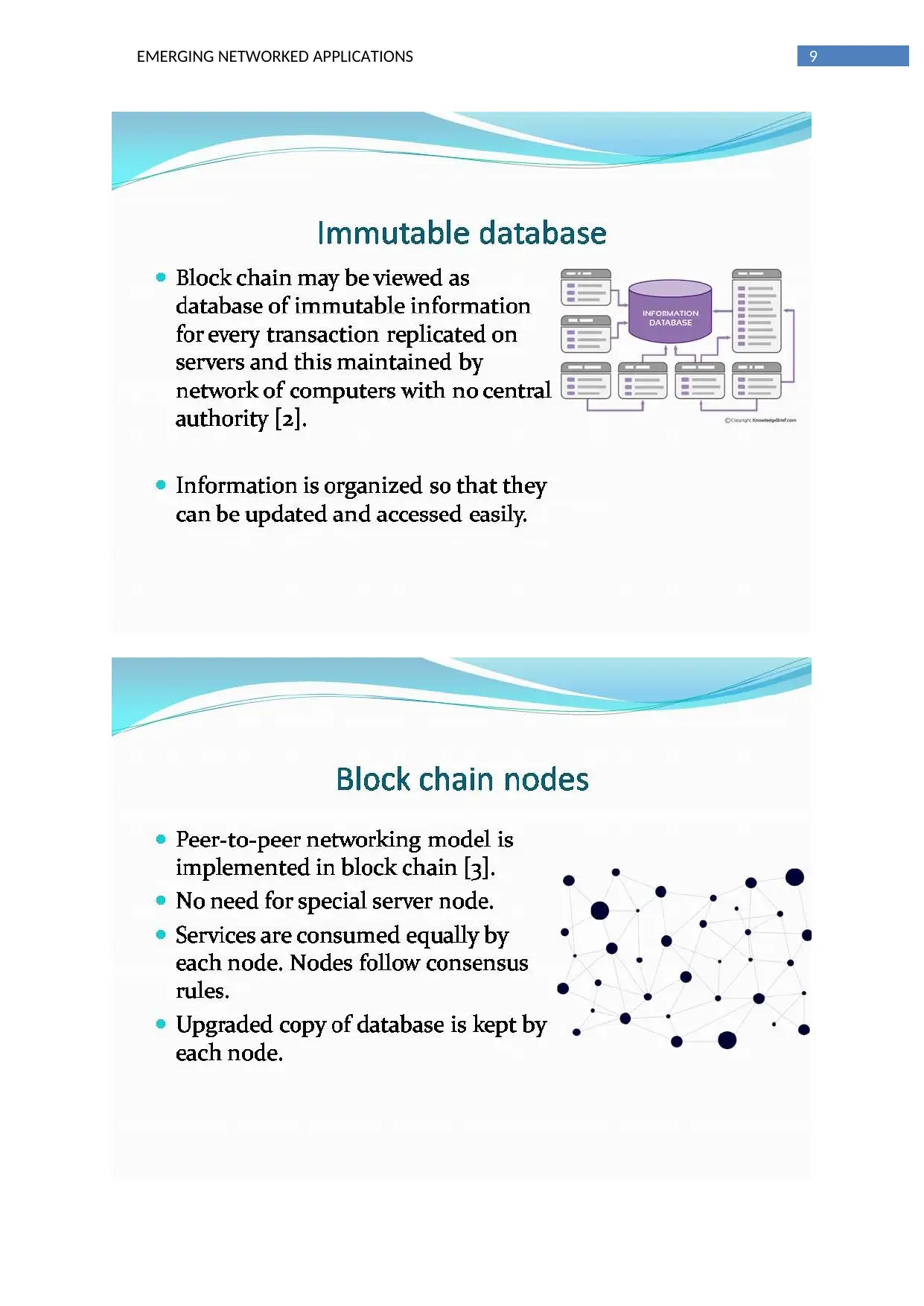
9EMERGING NETWORKED APPLICATIONS
Paraphrase This Document
Need a fresh take? Get an instant paraphrase of this document with our AI Paraphraser
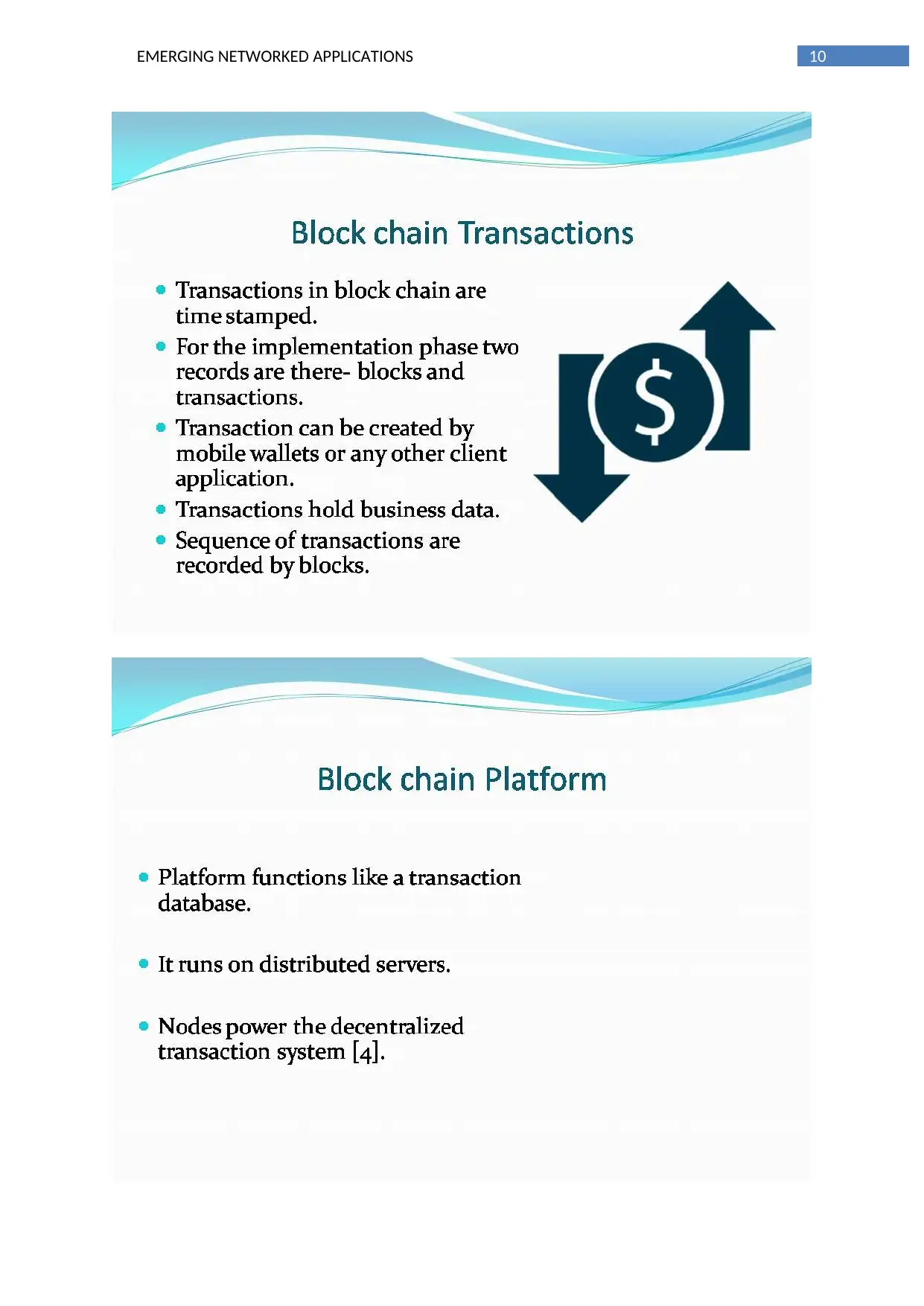
10EMERGING NETWORKED APPLICATIONS
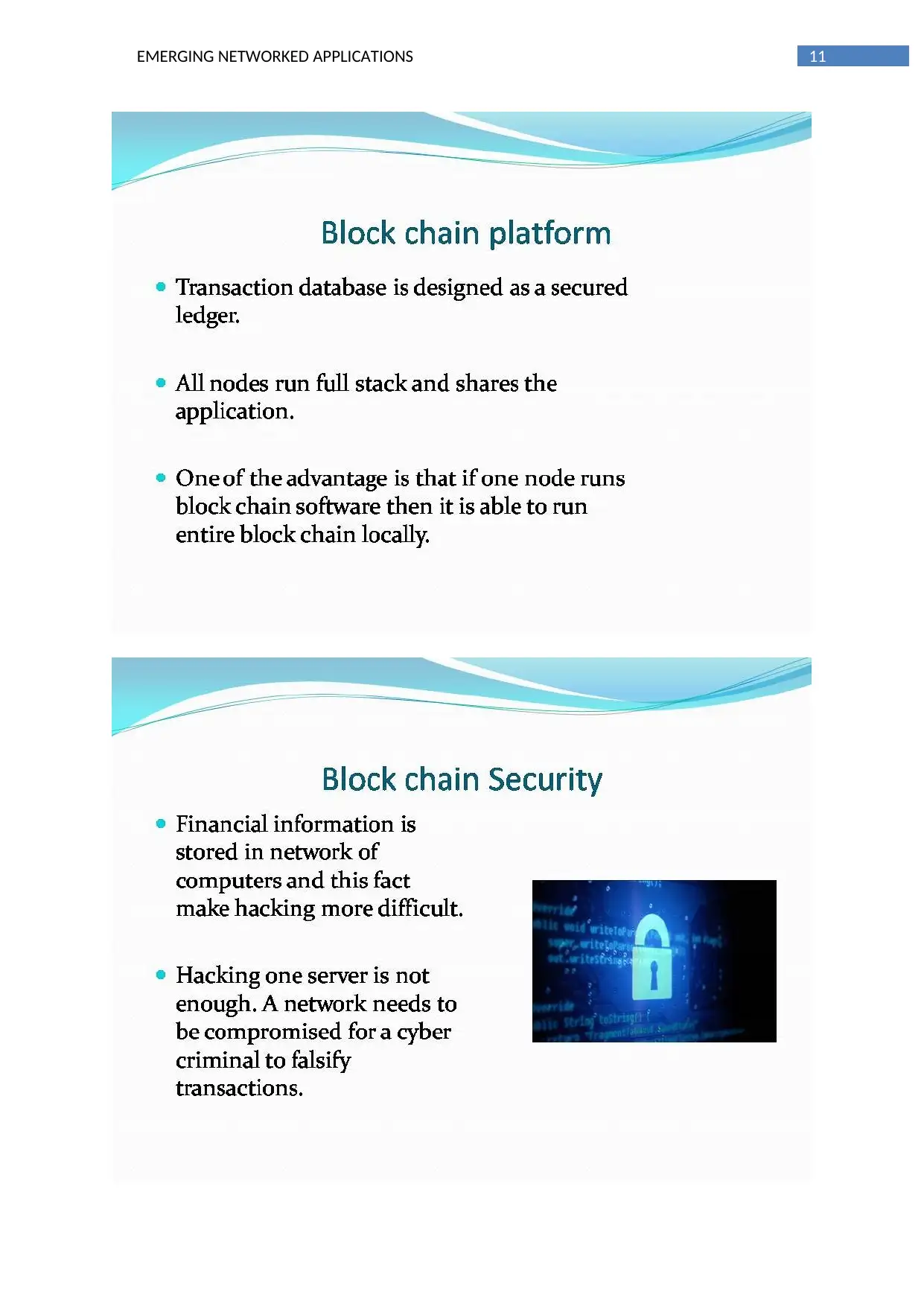
11EMERGING NETWORKED APPLICATIONS
⊘ This is a preview!⊘
Do you want full access?
Subscribe today to unlock all pages.

Trusted by 1+ million students worldwide
1 out of 15
Related Documents
Your All-in-One AI-Powered Toolkit for Academic Success.
+13062052269
info@desklib.com
Available 24*7 on WhatsApp / Email
![[object Object]](/_next/static/media/star-bottom.7253800d.svg)
Unlock your academic potential
Copyright © 2020–2025 A2Z Services. All Rights Reserved. Developed and managed by ZUCOL.





